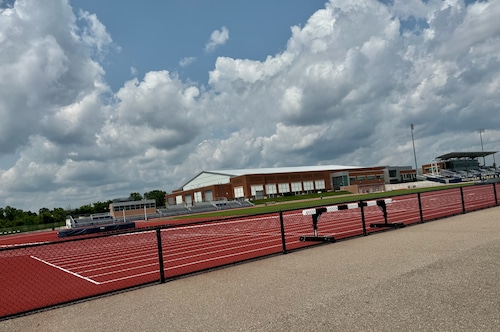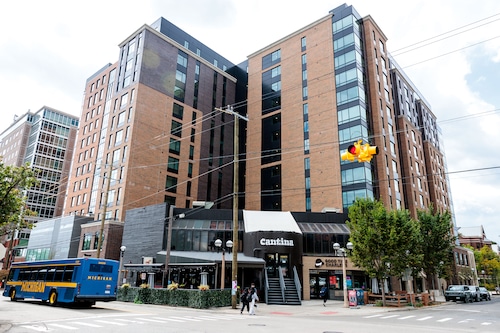This story is part of a series exploring how the University of Michigan’s expansion impacts Ann Arbor, from its economy to its businesses to its history. Stories on this topic will be published throughout the week.
ANN ARBOR, MI — A 10-story Main Street apartment high-rise that opened two years ago in downtown Ann Arbor now pays nearly $3 million per year in property taxes.
Roughly $687,000 of that goes to the city for police and fire services, roads, parks and more, while other dollars fund schools, libraries, county government and public transit.
That’s just one of many private developments like it in the past two decades catering to the need for more student housing as University of Michigan enrollment grows.
Read more: Is the University of Michigan’s Ann Arbor expansion a good thing? Here’s what Townies think
While city leaders lament many properties have come off the tax rolls as the tax-exempt university itself has expanded, the flip side of the coin is the city’s tax base has grown significantly, more than making up for those losses, as the town has built up around the growing university.
Each new student high-rise pays anywhere from under $1 million to over $3.5 million per year in property taxes, an MLive/The Ann Arbor News analysis of city tax records shows.

South University Avenue including student-oriented high rise apartments Vic Village South, left, and Vic Village North, alongside long-standing businesses like Cantina, also known as Good Time Charley’s, in Ann Arbor on Tuesday, Oct. 1, 2024.Jacob Hamilton | MLive.com
Fourteen of the largest student-oriented apartment developments built downtown over the past 20 years — most of them high-rises branded as upscale student housing — collectively pay over $25 million per year in property taxes, of which the city’s portion is over $6 million, MLive’s analysis shows.
And that doesn’t count new taxes from other major developments that have followed UM’s growth in both students and workers.
“Those student high-rises are what’s keeping our budget afloat,” said City Council Member Jen Eyer, D-4th Ward.
Nonetheless, Ann Arbor officials are still grappling with some statistics they consider worrisome.
As the university has continually added new campus facilities since 2000, it’s costing the city $2.4 million annually in lost tax revenue, and cumulatively it has cost the city more than $25 million, not counting other tax revenue that would have gone to entities such as schools, the city calculated last year.
Read more: University of Michigan’s growth costing Ann Arbor millions in lost taxes, city says
The amount of tax-exempt land owned by the state and university in Ann Arbor now totals 1,748 acres or 9.4% of the city, according to City Assessor Jerry Markey.
“There is no question that the continued expansion of the university within the borders of the city of Ann Arbor — the purchase of land that takes it off the tax rolls — has a negative consequence on city revenue and hurts our ability to fund the basic services and quality-of-life advancements that residents and community members are looking for,” Mayor Christopher Taylor said.
The city is creating an economic development office, aiming to strategically grow and combat erosion of the city’s tax base.
“It’s going to be a critical responsibility of the economic development director to help us stave off further gobbling up of our land by the university,” said Eyer, a proponent of the new initiative.
“The goal is to not have that happen again,” she said of letting UM take over big chunks of land like a 17-acre property on State Street where UM expanded its athletic facilities and city officials saw a missed opportunity for housing development.

The former headquarters site of printing company Edwards Brothers Malloy, a nearly 17-acre property on South State Street the University of Michigan purchased and took off Ann Arbor's tax rolls several years ago to expand its athletic campus facilities, including track and lacrosse, as seen on July 23, 2024. City officials now consider it a missed opportunity for housing development and a prime example of the city's concerns about UM's expanding footprint impacting the city's tax base. (Ryan Stanton | MLive.com)Ryan Stanton | The Ann Arbor News
Like other governmental and nonprofit institutions, UM is exempt from property taxes as it provides a public good.
The university maintains it makes other important contributions to Ann Arbor by providing access to higher education for residents and has a long history of substantial financial investment in the city.
City officials aren’t entirely against university growth. They say the city and UM just need to find common ground on a plan for expansion while protecting the tax base.
Eyer said she’s particularly concerned about moves UM has made to acquire more land to build campus housing.
“I would rather it be private development,” she said. “Because if they’re going to build their own housing, that’s just taking more land off tax rolls and taking that opportunity for private development to add to our tax base.”
Read more: As the University of Michigan swells in size, some fear it’s bulldozing history
The idea of getting the university to voluntarily make payments in lieu of taxes to the city — what’s known as a PILOT agreement — has come up in city discussions over the years, but UM has never been willing.
“That was made clear when I got to town in 2021 that’s not something they do or would consider,” City Administrator Milton Dohoney said.
Cities in some other parts of the country have PILOT arrangements with their colleges and universities that translate to multimillion-dollar payments yearly.
For example, Boston collected over $15 million in voluntary cash payments from tax-exempt educational institutions in the city in 2023, including over $4 million from Harvard University and over $6.3 million from Boston University, in addition to other calculated benefits provided by those institutions.
In Providence, Rhode Island, city officials approved new agreements a year ago with four local colleges and universities to have them make voluntary payments totaling $223.5 million over 20 years, including nearly $175 million from Brown University. That’s in addition to other contributions such as investments in K-12 education, community programming and scholarships for local residents.
“The approval of these landmark agreements marks an extraordinary moment for the city and its higher education institutions, and we’re proud to have cemented Brown’s investments in the success of Providence for decades to come,” Brown President Christina Paxson said in a statement. “The agreements are rooted in a spirit of partnership and a commitment to helping the city and its residents thrive.”
If UM ever decided to make similar payments, Ann Arbor officials said that would be wonderful, but they don’t have high hopes.
“What would their incentive be?” Eyer asked.

Flute musicians play during University of Michigan Marching Band practice at the new Elbel Field in Ann Arbor on Aug. 21, 2024. UM purchased the former Fingerle Lumber property and took it off the city's tax rolls to make way for the new field.Josh Boland | MLive.com
“It’s important to realize that the political and legal environments in Massachusetts and Rhode Island and elsewhere are vastly different from the political and legal environment here in Michigan,” Taylor said, noting UM is an entity created by the state Constitution and supersedes the city in government hierarchy.
That gives the university constitutional autonomy, Taylor said, and UM doesn’t have to follow city ordinances — like a ban on digital billboards, which didn’t stop UM from installing a 48-foot-wide one outside the Big House years ago.
Some cities in other states have been able to negotiate PILOT agreements with their universities because they have more leverage than Ann Arbor does with UM, Taylor said.
“A university wants to build a dorm in a location, zoning won’t allow it, and the university chooses, coincidentally, to offer a PILOT at that time, then the zoning changes,” he said.
In Ann Arbor, if UM wants to build something, the city essentially has no say over it.

A new University of Michigan student dorm under construction on Hill Street in Ann Arbor on Oct. 8. 2024. (Ryan Stanton | MLive.com)Ryan Stanton | The Ann Arbor News
While UM hasn’t budged on the idea of a PILOT, spokesperson Colleen Mastony said the university remains committed to investing in the city, including significant contributions to infrastructure projects that benefit the broader community.
In fiscal year 2023, UM contributed over $23.7 million toward repaving roads, renting public rights-of-way and installing upgraded water, sewer and stormwater lines, she said, adding UM’s contributions in those areas have averaged over $20 million annually the past three years.
“The university is currently in discussions with the city regarding future infrastructure projects that we might jointly undertake in the coming years,” Mastony said. “This ongoing collaboration underscores our commitment to supporting the city’s development and maintenance needs.”
Tax issues aside, city officials said they view the town-gown relationship as a positive one that has improved in recent years. That’s in part, they say, because Dohoney and Santa Ono, UM’s president since 2022, had a previous working relationship in Cincinnati and there’s mutual respect and trust, and former City Council Member Chris Kolb is now UM’s vice president for government relations.

City of Ann Arbor Mayor Christopher Taylor and University of Michigan President Santa Ono shake hands during the Bicentennial Tree planting at Nichols Arboretum in Ann Arbor on Sept. 4, 2024. Josh Boland | MLive.com
Dohoney said he communicates on a regular basis with UM officials and looks for opportunities to partner. He cited the university’s $425,000 donation to the city for improvements to Bicentennial and Fuller parks and $132,000 to help the city roll out high-tech public restrooms downtown as examples.
The university also has worked with the city on a $14 million project to widen and rehabilitate the East Medical Center Drive bridge in front of UM’s medical complex, with UM covering $9 million of the costs.
“The fact that we are in a much better place in terms of town-gown is evident in the fact that they’re doing those kinds of things,” Dohoney said.
The city and university also are cooperating on strategic talks about growth and downtown vibrancy, he said.
Ann Arbor is now searching for a director to lead its new economic development office, and Dohoney hopes to make a hire by the end of 2024 or early 2025. The director will hire and oversee a coordinator.
“We’ve got to build up the capacity to be able to go after real estate opportunities,” Dohoney said.
But he doesn’t view UM’s expansion with alarm.
“It’s something that we know exists and we expect that the university is going to continue to do what it does in terms of expanding to meet its own needs,” he said.
“So what we have to do, and what we’re trying to do based on policy decisions that the City Council has made, is we’re going to accelerate our own efforts around economic development. And we’re going to be more focused on placemaking and growth, particularly around housing in the city.”

Vic Village South, a new apartment high-rise catering to University of Michigan students, towers over Cantina and Good Time Charley’s on South University Avenue in Ann Arbor on Oct. 1, 2024.Jacob Hamilton
Taylor, who came to the university on a music scholarship in 1985 and now has four degrees from UM, said Ann Arbor is fortunate to have the university and there isn’t a mayor anywhere who wouldn’t want an institution like UM in their town. Though they have different missions, the success of the university is crucial to the success of the city, and vice versa, he said, and they’re working well together.
“Bottom line, the University of Michigan is an incredible community and municipal resource,” he said. “And whatever occasional friction exists pales in comparison to our mutual interests and, frankly, I believe, our mutual respect.”
Read more stories here about the University of Michigan’s expansion throughout Ann Arbor.
Want more Ann Arbor-area news? Bookmark the local Ann Arbor news page or sign up for the free “3@3 Ann Arbor” daily newsletter.

Stories by Ryan Stanton
- See ways downtown Ann Arbor may change under new list of recommendations
- New map shows big ways Ann Arbor may be rezoned for more density
- 12 Days to Election 2024: Gen Z Michiganders are ready to vote
- Learn about latest ideas for rethinking downtown Ann Arbor
- Going to the Michigan vs. MSU game? Detroit-Ann Arbor buses to run late into night

